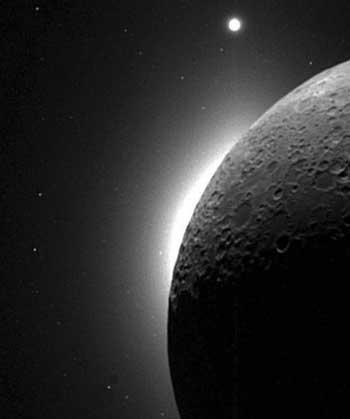Source: NASA
10-19-2007 11:49
 |
The lunar exosphere -- that is, the materials surrounding the moon that make up the lunar "atmosphere" -- consists mainly of gases that arrive as the solar wind. The solar wind is a continuous flow of gases from the sun -- mostly hydrogen and helium, along with some neon and argon.
The remainder of the gases in the exosphere form on the moon. A continual "rain" of micrometeoroids heats lunar rocks, melting and vaporizing their surface. The most common atoms in the vapor are atoms of sodium and potassium. Those elements are present in tiny amounts -- only a few hundred atoms of each per cubic centimeter of exosphere. In addition to vapors produced by impacts, the moon also releases some gases from its interior.
Most gases of the exosphere concentrate about halfway between the equator and the poles, and they are most plentiful just before sunrise. The solar wind continuously sweeps vapor into space, but the vapor is continuously replaced.
During the night, the pressure of gases at the lunar surface is about 3.9 x 10-14 pound per square inch (2.7 x 10-10 pascal). That is a stronger vacuum than laboratories on Earth can usually achieve. The exosphere is so tenuous -- that is, so low in density -- that the rocket exhaust released during each Apollo landing temporarily doubled the total mass of the entire exosphere.
The surface of the moon is covered with bowl-shaped holes called craters, shallow depressions called basins, and broad, flat plains known as maria. A powdery dust called the regolith overlies much of the surface of the moon.
Editor:Yang Jie
